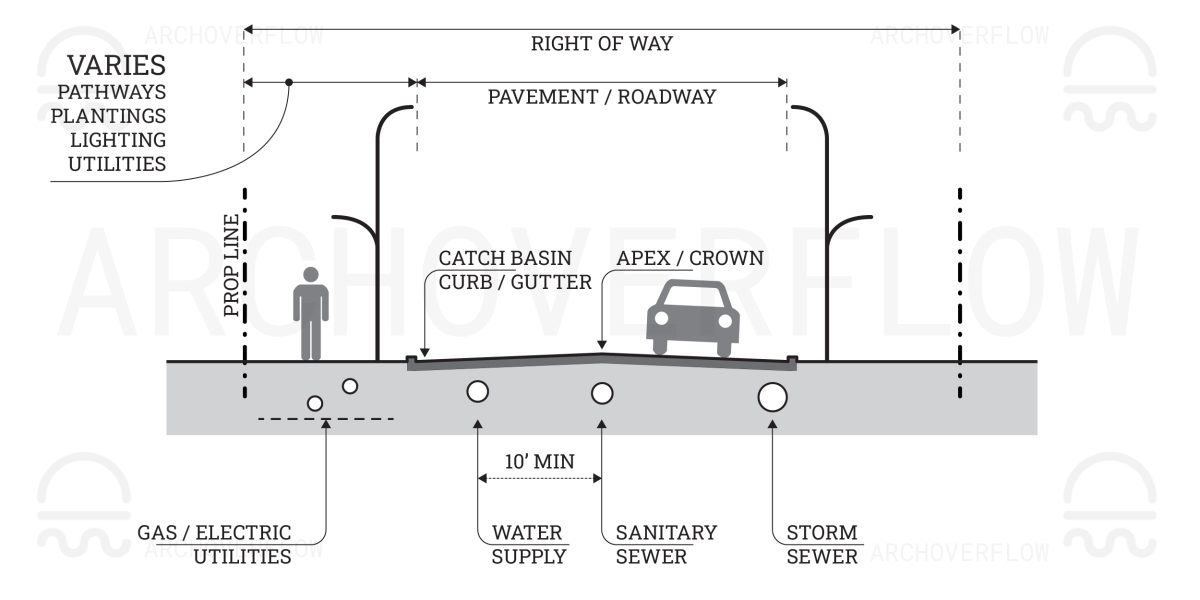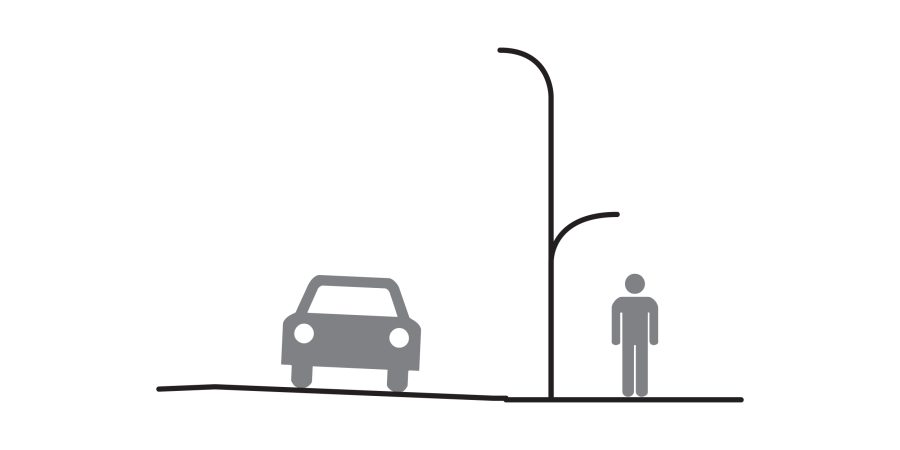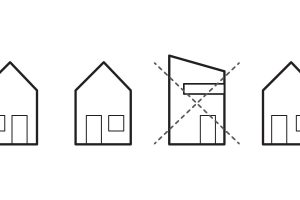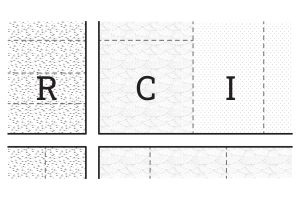Introduction
The Usefulness of any parcel of land, whether urban, suburban, or rural, depends on the existence of adequate access (roads), and depending on use, typically utilities to serve it. Regardless of other advantages, land is of little value for any kind of development if it’s not readily accessible, or if it cannot be serviced.
Therefore, a primary consideration in planning the use of a site is the adequacy of both circulation access and utility services. Circulation access may include pedestrian, vehicular, and public transit movement systems. Utility may include water, sewer, gas, electricity, and communication systems.
On the other hand, site access being difficult can be a selling point or ideal quality people are searching for, however, unless planning a camping site, there is still concern needed for access to utilities (whether existing or provided).
Definitions
Road Design: The design and layout of streets and parking on a site
Automobile Circulation: How the car will move around a site.
Site Layout
Site layout is the design and layout of roads/streets/utilities/etc that the community will use to access areas around the community. Typically, roads should be of sufficient width to make driving easy and at least wide enough to allow two vehicles to pass. Even one-way alleyways should provide sufficient area or spots for one vehicle to pass another. Road curves should be gradual and follow the natural topography of the site if possible. It’s always easiest (and cheapest) to follow the natural grading a site gives you.
Misc Rules of Thumb (Streets & Roads)
- There should be no blind curves.
- Forcing traffic through a parking area to get to a designated drop-off point should be avoided
- Street Widths: Traffic lanes for major roads vary from 11-12 feet.
- Street Width Minimum: Two-lane road designed for two-way traffic: 24’-0”
- Highway Width Minimum: Two lane highway with no divider/medium beyond painted line (allowing 9’-0” for shoulders on each side) is about 42 feet wide.
- 9’-0” + 24’-0” + 9’-0” = 42’-0”
Curbs:
- Streets with heavy use should have a 6” curb or gutter – in Urban areas this is sometimes reinforced with steel. Sometimes this will be concrete while the roadway may be asphalt.
- Minor residential streets can have 4” roll curbs or gravel shoulders flanked by drainage ditches.
Planting Strip
- Be at least 7’-0” wide to contain trees
- 4’-0” wide if it’s going to be landscaped in some capacity with plants/flowers. Care and maintenance should be considered to avoid cutting grass in dangerous areas.
Street Section Design
ArchOverFlow – Road/Street Paving Materials
Street Section:
- Slope of the street away from the crown should be ⅛” to ½” per foot, depending on the quality of the finished surface.
- Center of the street should be reserved for the wastewater (sanitary and sewer) trunk lines, unless it’s sufficiently wide to accommodate multiple wastewater systems.
- All utility provisions forecasted for the next 5 years should all be installed (including up to the curb) prior to the street being poured (to minimize removal and remedial work or pulling up a road to expand expected service). In reality, estimations out to 50 years would be better, but is not as practical in all situations..
Site Circulation Rules
Parking Spaces
Parking constitutes a major land use and therefore the location of parking spaces and parking structures should be carefully considered. An approaching driver should have a view of the building and a view of the parking area. A typical Automobile Circulation design is to provide the drive approach between the parking and the building, so the person has a view of the building and gets to also see the parking area. They are then free to choose a path.
- The design itself should provide direct, easy access to the parking area and building without excessive driving, turnarounds, dead ends, or conflicts with service areas and pedestrian circulation.
- Entry Drives should be located as far away from intersections as possible. Sometimes when the entry drive is to a large area like a shopping center, the entry drive will be purposefully located at a stop light so that access can be controlled.
- Entry and overall navigation should be simple enough where people will not get confused or turned around. Navigation should be simple and make sense.
Parking needs become more critical when the number of cars being parked reach 400-500 vehicles. When this happens, the need for on-site circulation systems connecting to the local public roads is generally needed. A common strategy is to deploy an on-site loop distributor-collector road that has access points carefully designed with the public roads. Such loops are Cartridge Roads. You will find most malls in America use this strategy.
Parking Facility Slopes
Refer to our Slopes & Ramps page here
- Walking distances in self park should ideally not be more than 300 feet before destination.
- 90 degree parking spaces are most often used for efficiency and to permit two-way traffic flow.
Service Areas
Service areas and automobile circulation should be kept separate if possible. Enough space at the service area should be provided to allow the service vehicles to turn around or back-up. If the service access is provided via normal traffic routes, that traffic route needs to be widened to allow for the service vehicles.
Pedestrian Circulation
Pedestrian circulation routes should provide convenient, safe, direct access from the various points on a side, including to/from the parking areas to the building entrance. Sidewalks should provide the most direct paths from one point to another, since people generally opt to take the shortest route possible regardless of whether the sidewalk is located in this path or not. If possible pedestrian paths should not cross roads, parking lots, or other areas of potential conflict. Proper signage and care should be taken when paths do cross roadways.
Collector Walks: Located adjacent to parking areas so people can travel from their cars on a separate walk that is safe and protected. Can be separate from the parking, or integrated into the parking.
Misc Notes & General Rules Of Thumb
- Sidewalks next to parking where car bumpers might overhang the curb should be a minimum of 6’-0” wide.
- Required amenities such as trash cans, lighting, etc, should be provided next to the walk but not take away from the minimum required width
- Walk should have a cross slope of ¼” per foot for drainage

Pedestrian Paving Materials
ArchOverFlow – Road/Street Paving Materials
There are many types of paving materials that are common for pedestrian circulation, much more of a variety than paving materials of roads. The most common is concrete because of its strength and durability.
- Concrete should be laid over a gravel subbase with control joints every 5’-0” and expansion joints every 20’-0”. Walks are usually 4” thick.
- Additional expansion joints should be located wherever the walk butts up to adjacent construction.
Sidewalk Paving Materials
- Brick Paving: Very popular and durable for pedestrian traffic.
- Stone Cobbles: Mainly used for decorative effects, best cobbles are rounded riverbed tones, from 2-4” in diameter.
- Granite: Small, rectangular or square blocks of granite that are set in a cement mortar to produce a very durable paved surface.
- Flagstone: Thin slabs of slate, bluestone, or soapstone. Available in many different finishes and textures.
Grade Changes For Walking Surfaces:
Grade changes are achieved with ramps and stairs. There must be provisions for making the site accessible to the physically disabled, and all elements of accessible routes from handicapped parking areas to the building entrances must comply with the required slopes, widths, and all other accessibility guidelines such as warning strips and graphic signage. See the ADA Design Guidelines.
Utilities
Utility systems, while largely unseen, should be understood as they affect land and site planning quite a bit. The Architect, before beginning design, should contact the local utility companies to confirm their requirements for providing service to the building and to locate existing utilities if they do exist. Not all utilities are available at all sites.
- Utilities should be considered to occur anywhere in the right of way along the street section. The Architect may request locations or design spots for poles, but it is up to the jurisdiction for locations within the right of way.
Water Supply And Distribution
Water is essential to life and the wellbeing of a community. Its supply and distribution should be a major element in a community’s comprehensive development plan. To see what happens when water distribution goes wrong, review the issues with Flint, Michigan and their water supply.
Average demand of water is 150 gallons of water per capita (person) per day. (varies heavily)
- Piping and conduit may be cast iron, wrought iron, steel, or plastic. With really large sizes, reinforced concrete may be used.
- 6” – water main in typical residential areas
- 8” – in high density districts.
- Water shut-off valves are normally located at the user’s property line. Water meters (which measure the amount of water being used) are typically located on the building somewhere. Smart meters are able to transmit data to the water company directly or via small remote distances.
- Main line valves are ideally located so that no single break will affect more than 500’ of water main.
- Fire hydrants – placed normally
- 150’ apart in high density districts.
- 600’ feet apart in suburban areas.
- Some communities may not have fire hydrants depending on density.
- Public water supply is not normally justified in areas with density less than 1,000 persons per square mile. In remote areas, the groundwater is accessed by well systems. When more capacity is needed, multiple wells can be installed. Wells can typically extend at least 50 feet and at most 500 feet. Wells must be located away from septic systems and away from any other potential contaminants.
Misc Notes & General Rules Of Thumb:
Typical utilities: Sanitary sewers, storm sewers, water lines, natural gas, electricity, steam, telephone (legacy, less so now), internet/data, cable, and others.
- Trunk Lines should not be located in major traffic arteries if possible (for access and maintenance if required).
- Trunk Lines for several utilities should not be located in the same street
- As the slope of a drainage pipe decreases, the size of the pipe must increase to maintain flow. Therefore, the smaller the pipe, the more it needs to slope. The larger the pipe, the less it needs to slope.
- Note: If existing utility trunk lines are not convenient to the site, it will be necessary to coordinate with the utility companies to determine how the utilities will reach the structure, and to establish the associated costs so that these expenses can be included in the project budget. Depending on the local government, they may or may not help pay for this work.
Utility System Definitions
Transmission Mains: Including aqueducts, canals, pipelines – transmit raw water to treatment plants or to the distribution systems of untreated water.
Distribution Systems: Convey the water to the users properties, may include reservoirs and pumping stations
- In urban areas, the distribution is determined by the street plan, urban density, and topography.
- Installed in a branch or gridiron system
- Gridiron systems can be improved by installing a “Looped header” – this ensures supply from more than one direction. This allows one line to be serviced or damaged without disrupting the system.
Metered Connections: Connection between the distribution systems and users properties.
Electricity
Electrical power is generated primarily by turbines powered by steam produced by burning coal, oil, or gas, and sometimes water power. More recently wind and solar power have finally reached the technological ability to produce enough power for home and city service.
Substations are located and placed to help dictate and create “service areas”. Substations may be located underground, in buildings, or enclosures behind screen walls/fences/landscapes.
On Demand Power – Sustainability
On demand power refers to the ability of power to be called on demand at any point in time, regardless of the situation. This is of concern in emergency situations where infrastructure gets fractured or weather is inclement. Typically, ‘green energy’ is not considered as part of this, as solar and wind cannot always be drawn upon regardless of conditions. Instead, this would refer to traditional fossil fuels such as oil and gas.
Telephone/Telegraph
Telephone trunk lines are generally placed underground in conduits.
Telephones are especially important in regards to police and fire alarm systems. They are less used due to cellular phones, however are still needed for emergency systems in certain situations.
CATV
Cable antenna television is popular in areas that lack conventional TV broadcast.
Gas Utility Lines
Gas is one of the most useful fuels for home. Gas is pressurized in transmission lines over long distances. Regulating stations are located in various parts of a community in residential areas, they are most often located in an underground vault.
Gas can be manufactured in facilities if needed (in industrial areas).





Leave a Reply
You must be logged in to post a comment.